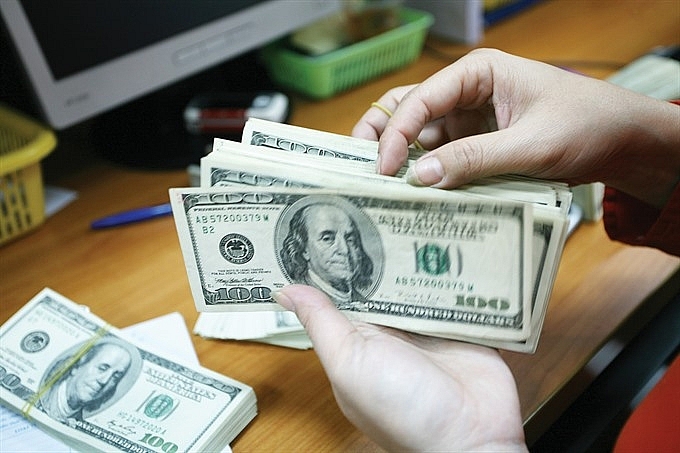Volatility returns to foreign exchange rates
 |
| Volatility returns to foreign exchange rates |
Following the central bank’s move, many banks immediately adjusted their exchange rates.
Vietcombank decided to reduce the đồng’s value by VND45, setting its dollar buying rate at VND22,820 and selling price at VND22,890.
The exchange rate on the open market stood at VND23,000 to the dollar.
But on the following day (May 30) the dollar lost value. Eximbank cut its buying and selling rates by VND50 to VND22,770 and VND22,860, and Vietcombank by VND35 to VND22,785 and VND22,855.
The SBV reduced the interbank exchange rate by VND15 to VND22,590 per dollar.
The sharp fluctuations belied the predictions of many experts, who had said exchange rates would remain stable through the year.
In the first four months of the year the rates were indeed steady thanks to certain conditions, one of which was the strong GDP growth in the first quarter, estimated at 7.38 per cent, the highest quarterly rate in 10 years.
Overseas remittances reached a record US$63 billion, while foreign direct and portfolio investments poured in.
A report by HSBC had predicted the đồng to remain steady against the US dollar and end this year at VND22,900.
It was predicated on high capital inflows and the đồng’s weakness against other currencies in the region.
Explaining the sudden fall in the đồng’s value against the dollar, analysts said the relentless rise in the US Federal Reserve’s dollar base rate under a roadmap and the sharp rise in interest rate on US bonds made the greenback stronger.
Recent global political and economic events have also caused pressure on Vietnam’s foreign exchange market.
A large trade deficit and sharp drop in the stock market in May also affected the exchange rate.
According to latest data from the General Statistics Office, the trade deficit topped US$500 in May.
On May 29 the benchmark VN-Index on the HCM Stock Exchange closed at 931.75 points, its lowest level in more than five months.
The financial market reported an upward trend in foreign currency lending in spite of the central bank’s efforts to reduce it.
In 2017 foreign currency loans had risen six times. In the first quarter of this year đồng loans were up by 3.3 per cent while foreign currency loans registered a 5.4 per cent increase.
Foreign currency loans are attractive because their interest rates are always much lower than on đồng loans, and for a long time now the exchange rates have been steady.
The rates on foreign currency loans now range between 3.5 per cent and 4 per cent while those on short-term đồng loans average 7-8 per cent.
After edging down on May 31 the đồng showed signs of weakening again on June 1. The SBV announced a central rate of VND22,595 to the dollar, depreciating the đồng by VND5. Its reference rates were VND22,700 and VND23,248.
Analysts believe the forex rates will continue to remain volatile on the back of high US bond yields and other reasons.
They have called for diversifying currencies used for enterprises’ import, export and investment activities since Vietnam is integrating deeply with the global economy.
To reduce risks related to the forex rate volatility, the SBV has called on enterprises to use tools like hedging.
Among the most effective tools for foreign exchange risk management now is currency derivatives, including forward, swap, option and future contracts, which enable enterprises to buy or sell specific quantities of a particular currency pair at a future date.
Since 2008 many companies have indeed been using currency derivatives.
According to experts, banks need to offer services that can help enterprises mitigate foreign exchange risks in their business transactions.
The central bank needs to continue with its flexible foreign exchange regime and ensure the foreign exchange market accurately reflects supply and demand.
What the stars mean:
★ Poor ★ ★ Promising ★★★ Good ★★★★ Very good ★★★★★ Exceptional
Related Contents
Latest News
More News
- Legal framework completed for national digital transformation (December 13, 2025 | 21:55)
- SOAR initiative launched at TECHFEST Vietnam 2025 (December 13, 2025 | 10:00)
- Promoting digital assets initiative in Vietnam (December 13, 2025 | 09:30)
- Legislation gives government flexibility for loan guarantees (December 11, 2025 | 18:04)
- Vietnam masters core technologies of automobile value chain (December 11, 2025 | 17:46)
- Japanese investors pursue M&A strategies with long-term vision in Vietnam (December 11, 2025 | 12:14)
- Raising product quality to secure Vietnam’s position in US market (December 11, 2025 | 12:00)
- Industrial sector posts robust gains as year-end demand rises (December 09, 2025 | 13:38)
- ASEAN economies move up the global chip value chain (December 09, 2025 | 13:32)
- Reforms urged to unleash private-sector power (December 07, 2025 | 09:00)

 Tag:
Tag:





















 Mobile Version
Mobile Version